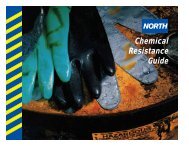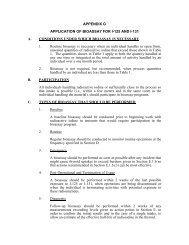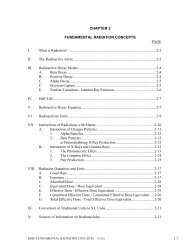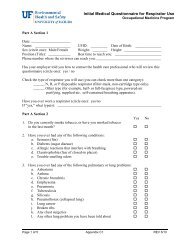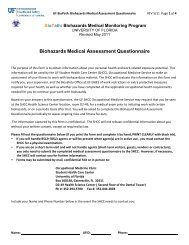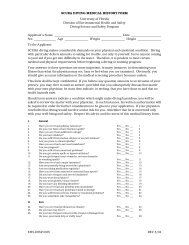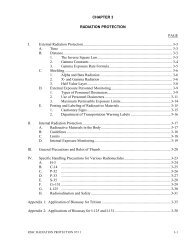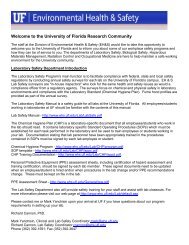Biological Safety Manual - University of Florida
Biological Safety Manual - University of Florida
Biological Safety Manual - University of Florida
You also want an ePaper? Increase the reach of your titles
YUMPU automatically turns print PDFs into web optimized ePapers that Google loves.
Laboratory DecontaminationSpace decontamination is a specialized activity and must be performed by specialists with proper trainingand PPE as this typically requires gaseous decontamination (formaldehyde) or hydrogen peroxide vapor.Please contact the Biosafety Office for additional information regarding decontamination <strong>of</strong> large spaces.Liquid chemical germicides formulated as disinfectants may be used for decontamination <strong>of</strong> surfaces.The Biosafety Office recommends 10% chlorine bleach (approximately 5,250 ppm chlorine) as aninexpensive effective disinfectant for routine use (please confirm effectiveness on the specific biohazardin-use). Additional information regarding the activity levels <strong>of</strong> select liquid germicides may be located inthe BMBL appendix B.EmergenciesAll personnel handling biological agents must have the proper training and experience to work with thesematerials safely. The laboratory-specific SOPs must also include procedures to ensure a safe workenvironment during an emergency, as well as protocols for specific incidents including spills, releases,exposures, laboratory accidents or theft/loss <strong>of</strong> an agent. Further, emergencies and incidents might alsohave far reaching effects beyond the individual or laboratory involved, therefore detailed notification andcommunication protocols should also be developed to ensure the incident is properly managed. Thefollowing summarizes the major elements to be addressed in the laboratory-specific SOP and stafftraining programs.In the event <strong>of</strong> a major disaster affecting the campus, the UF Homepage is the <strong>of</strong>ficial source <strong>of</strong>UF emergency related information.Personnel should know what constitutes a potential exposure or release and report these to thePI or lab supervisor immediately. The PI or lab supervisor must then report this to the BiosafetyOffice within 24 hours and, as appropriate, to medical care providers.All personnel must be familiar with the hazards/risks <strong>of</strong> the materials they handle and thesymptoms <strong>of</strong> disease or illness associated with these materials. This allows the discovery <strong>of</strong> apreviously undetected exposure or release and countermeasures taken to prevent further harm.Time and situation permitting, contain and secure all biological agents during any and allemergencies. Agent storage areas shall remain locked to ensure security is maintained as well asprotecting first responders from a potential exposure.Familiarize oneself with the location and operation <strong>of</strong> emergency equipment such as the eyewashstation, safety shower, first aid kit, chemical and biological spill kits, fire extinguishers andemergency exits.PIs and lab supervisors should periodically review emergency procedures and information withlab staff and students. Quick reference protocols and emergency contact information should beposted in the laboratory. See Handouts section on the Biosafety website.When possible, lab staff, PI/lab supervisor should meet and escort emergency personnel on site.All emergencies are better handled by two persons. The buddy system is required when workingwith hazardous materials, particularly after normal business hours on weekends or holidays.Emergency Contact Telephone Numbers are located on the EH&S website emergencies page.Personnel Responsibilities/Assignments During a DisasterAll laboratories and/or research areas should pre-assign an individual(s) to perform the following tasks inthe event <strong>of</strong> a disaster:Determine the whereabouts <strong>of</strong> all employees and reiterate emergency assignments.Notify departmental administration during normal business hours, or after hours call the <strong>University</strong>Police Department Communications Center at (352) 392-1111.Secure buildings and properties. Report status <strong>of</strong> employees and unit to appropriateadministrators.47




